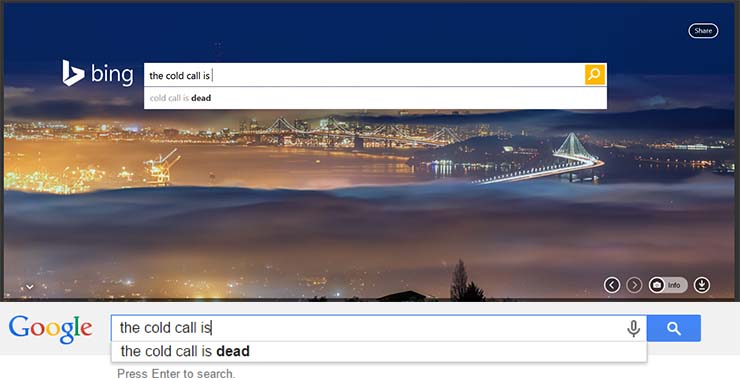
The Cold Call is Dead: How Sales is Changing in the Era of Personalization
Predictive text on search engines can shed a lot of light on what people believe, and one of the latest adages to take hold in the B2B sales and marketing space is the idea that the cold call is dead.
After all, what place does calling someone cold – out of the blue with no context and no relationship – have in a new era of technology where personalization almost goes without saying (anonymity, on the other hand, is quickly becoming a *feature* re apps like Secret, Facebook’s Rooms or services like Torr).
As much as we love clickbait, the reality is that cold calling isn’t exactly dead. Salespeople will vouch for the fact that every opportunity starts with a call.
The Internet, social, and mobile technologies have all changed the way we buy, but the phone is still a critical tool for a salesperson in reaching out to prospects. While the phone as a channel may seem outdated, the real reason that phones may be outdated is when they are used with the cold calling practices of the past. Cold calling is neither dead nor a waste of time, but it has definitely undergone a major transformation.
The cold call isn’t dead, but like many forms of communication, it is being profoundly shaped by the rise of social and the consumer expectation that companies tailor their messages to each individual.
Today’s customers make purchases on their own terms. They research online before walking into a store or talking to a sales rep. CEB analysts found that customers are 57% of the way through the buying process before they ever engage with a sales rep. SiriusDecisions reports that customers are 70% through the buying process for complex sales.
This means that sales and marketing must partner more closely than ever to influence customers before they have reached out to a sales rep. Sometimes this includes actively prospecting on social channels before a customer has reached out to you. According to insidesales.com, 50% of sales go to the first salesperson to contact the prospect.
I recently had a conversation with Ryan Blakely, who runs an inside sales team at Microsoft. Because he monitors his target accounts on Twitter, he was able to see when a prospect tweeted that they had saved $300K by switching to the Azure platform and reach out at a time when the organization was leveraging the cloud to drive cost savings. While traditional cold outreach seldom results in a meeting, Ryan was able to connect with this prospect after a single message.
The cold call isn’t dead, but like many forms of communication, it is being profoundly shaped by the rise of social and the consumer expectation that companies tailor their messages to each individual. The most effective sales reps use social technologies to personalize their outreach – and the most effective companies will utilize technologies that make that personalization an easy step for sales, for example, embedding social insights into customer relationship management (CRM) platforms.
Read more on social sales in our ebook: Social is for Closers.
Read more on sales productivity in our ebook: Always Be Closing.

